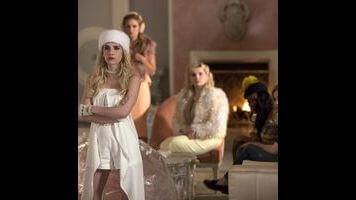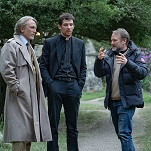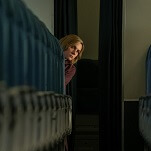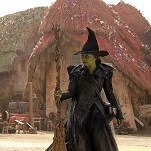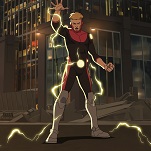It’s rare you learn so much about the id of a showrunner at every turn as you do with Ryan Murphy. That bizarre honestly is sometimes all you can say about Ryan Murphy’s craft in a particular moment, but whether he’s playing spin-the-bottle with characterization on Glee or hurling shock-imagery spaghetti at the walls on American Horror Story, it’s illuminating. That’s not to dismiss that unshakably-creepy undercurrent of emptiness to some of his work—it just means that the emptiness is genuine. Whatever he has to offer, we’re seeing it unfiltered and unashamed. (We’ve all seen that lineup of the men in AHS: Hotel, right? This is not a showrunner out to subsume what he enjoys in favor of narrative objectivity, is all.)
After “Ghost Stories,” for example, it’s easy to assume that Ryan Murphy (who penned this episode) doesn’t know what lampshading is; this episode’s so meta that if he did know, Kappa Kappa Tau would likely have gotten a home décor delivery by the beginning of Act Three.
This has, of course, always been a meta show, for which the horror plot is a twisty necessity that’s almost beside the point. It’s much more interested in trying to capture the why-the-hell-not weirdness of iconic horror movies. When that doesn’t work, you end up trapped in a camp-sausage factory. When it does, you get caught up in the genuine energy of a show that loves what it’s doing and all the monstrous sorority girls it’s doing it to. “Ghost Stories” lampshades the living hell out of itself (not for the first time), as the sisters of Kappa Kappa Tau prepare to evacuate the campus before shutdown—but not before Boone comes back for a little revenge, a Red Devil just misses Chanel #5 (again), and the Chanel crew repeatedly drops everything to settle down in front of an impressive series of fireplaces to listen to ghost stories.
There’s an invitation in all of this to examine the nature of narrative itself. Did Chanel #5’s abortive escape from campus—which falls out almost exactly like Hester’s meat-hook killer ghost story—exist to suggest that someone who’d heard that story was a Red Devil, or does it exist to suggest that the incident might, after all, have been in Chanel’s head all along? (She was alone—who can say how reliable a narrator she is? What camera is really objective?) Does Hester’s neck really snap when Chanel shoves her down the stairs, or is it just the Bedazzled neck brace she had coincidentally just begun to wear again? Does the fact that the ghost stories calm Denise and Hester and terrify everyone else comment on audiences’ own decisive feelings about horror, point to their culpability in some of these murders, or just contribute to the absurdity of hunkering down for terrifying death tales with a killer on the loose…again? Do we live in the stories we make for ourselves? Are we the toilet kappas we wish to see in the world?
But Scream Queens exists in an odd narrative limbo in which the plot is both vitally important and entirely beside the point. It might end up being the key to the entire Red Devil mystery that someone had access to toiler-paper dye in the minutes between Denise’s kappa story and her bathroom break; it’s certainly more likely to become relevant than the fact that several of its characters are pitched to completely different shows. It’s a little jarring to see Grace and Zayday hanging out in the main room during Hester’s big reveal, because whether a serial killer has a crush on her or not, Zayday and the Chanel crew are vibrating at such different frequencies it’s a miracle they can even see each other.
The litmus test for what side of camp you’re on? Boone.
Nick Jonas’ brief return to the series marked both a major reveal and a line of demarcation. The former worked fairly well; with only three episodes left in the season, it was definitely time to start unspooling some answers about the Red Devil(s), and it was satisfying to see Boone in the suit. It’s not the reason anyone’s still watching the show, but it’s definitely nice to have something settled before the finale. (The other Red Devil’s loyalty, for example!) But largely, it was an experiment in the absurd vs. the self-aware. Chanel #3, hilariously, assumes she’s being haunted, because why the hell not? Boone, who doesn’t have to worry long about where he fits in, decides to just pretend he’s a ghost until forced to admit otherwise. Zayday, being far enough outside the story, recognizes that bullshit from a mile away. And Chad—sweet Chad—is more than happy to welcome his bro back from the dead, so long as he’s cool with all the boning he saw from Heaven.
Going into the show’s back three, there’s still a sense of treading water as everybody tries not to spoil the last unmasking and/or finally ID that damned baby. But this show will make its own narrative momentum if the plot doesn’t provide any, and that final stair-shove (not quite a cliffhanger, since everybody but Hester saw that coming and I’m still not convinced Hester wasn’t also girded for it) is enough to make us wonder where, exactly, we draw the line for shitty characters to stay entertaining. Chanel #5 reminds us murder is probably awful, but this episode also reminds us that Chanel #5 is not someone we’re vested in. Murphy’s heart is with Chanel, and this show has never lampshaded with any more glorious clarity than when Chanel gives us Scarlett O’Hara eyes over the railing of the stairs as she utters, “And I’m confident that I’ll be able to redeem myself morally in everyone’s eyes.” She will, too; it’s why we’re here.
Stray observations:
- Scream queen of the week: LaToya might have compunctions about naming Chad Radwell too often, but I’m only a substitute, and have no such qualms. “Listen, you probably already know this because you saw it from heaven, but I kind of had sex with a few girls in your bed after you died. I didn’t mean any disrespect, I just kinda wanted that feeling of vacation sex, you know?” Sublime.
- Here’s a fun game: Watch the Chad and Hester scene and decide at what point the farewell crosses the line from funny to trying. Count the seconds after that. Realize how swiftly Fox backs the commercials up to the show’s bumpers, so that they seem more like smash cuts than a break between discrete acts. Decide if that, too, is a commentary on the show’s attempt to draw enough audience for another season by making it unclear when the show ends and the ads begin and trick us into watching at least half of one, or if it’s just a logistics issue because the show really wanted to hold on to that number of seconds of that scene. Decide if that was worth it.
- There’s a certain poetry to “the ghost of dead gay Boone,” no?
- Joaquin Phoenix beard jokes: The thrill of contemporary college campuses everywhere.
- Boone’s “once you go black, you never go black” explanation is the meathook-on-a-car-roof of this episode’s jokes.
- Lea Michele, the Ryan Murphy of acting, has poured every ounce of creepy intensity she has into Hester, and it’s given this show its biggest wild card, since she can sell any twist regardless of its ridiculousness without losing a sense of character focus. On the page, “I, for one, loved that,” is not a big line. In Michele’s hands, it’s both a big laugh and suitably chilling.
- Sacajawea: “the third wheel of Lewis and Clark’s gay camping extravaganza.”
- I wish there was a webseries paralleling this show that was just Jamie Lee Curtis’s reaction shots of the first cold reads of her scenes. I feel like that would be a really interesting show.
